#minimac systems
Text
Importance of Filter Carts and how to select the right one?

A lubricant filter cart is an important tool that can be used in many ways. From filtering all types of new and used oil to taking samples and transferring oil, filter carts are considered to be a must-have for an effective lubrication program. Oil filter carts have many benefits; they can be customized to fit any plant as per the uses and specifications. If designed, it can also give a warning if the unit needs servicing.
The uses and importance of filter carts are as follows
For cleaning the lubricants stored
For transferring the filtered oil to a machine or containers
For reconditioning of oil (currently in use)
For flushing (power, line, wand, etc.)
For contamination control functions (hose cleaning)
For meeting cleanliness standards
Subscribe to our Website Blog for more insightful Articles and Case Studies: Click Here
How to select the right filter cart?
If you don’t want your money to get wasted, select the right filter cart considering the below check-points:
Check the type of oil before buying a filter cart because carts are designed as per the viscosity levels. If a plant uses different types of oil then multiple filter carts are to be used.
Choose a filter cart that can be carried easily to the place of its application. Here, you have to consider the source of power as well.
Knowing your oil cleanliness target is very important before you buy filter carts. Don’t depend on the ISO standards entirely to evaluate used oil. Considering the specification of the type of oil is vital. We know that when viscosity increases, the cleanliness level decreases.
Check the oil flow rate. Powerful carts will cost you more, so it’s very important to know the filter’s flow rate before buying.
Customization of filter cart can be done, check before you buy if it matches your requirements or not. For example, the installation of bypass valves, dual filters, etc.
It is always better to take a second opinion than to stick with a single thought. It’s advisable to have a discussion with your filter distributor or manufacturer to find the best option. Remember that the filter cart must be chosen carefully and effectively to meet the cleanliness goals.
Reach us anytime to find the right Filter cart for your Plant - [email protected] or +91 70309 01267
#minimac systems#contact minimac#Oil Purification Systems#oil flushing#filer skid#filter replacements#Condition Monitoring#contract & services#oil purification machine#frf#lvdh#transformer oil cleaning#lube oil#hydraulic oil#chemical cleaning#oil filtration#filter machine#oil cleaning machine
2 notes
·
View notes
Text
Connecting a Modern MIDI Keyboard to an Apple IIGS
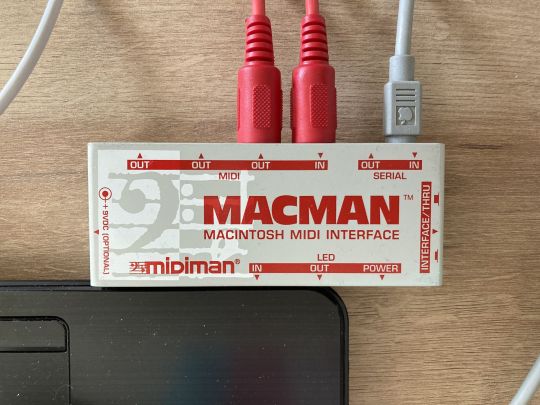
I love connecting MIDI keyboards to old computers. This is pretty straightforward for the Apple IIGS. GS/OS System 6.0.4 comes with synthLAB, a MIDI sequencer and synthesizer. After some trial and error attempts at diy-ing a serial based midi connection, I quickly came to the realization that the Apple MIDI driver works over the RS-422 connection. This schematic shows a basic MIDI to RS-422 setup, which could be a totally valid approach to solving this. We could also take the approach of looking for time-period-accurate MIDI interfaces. I found an article from 1997 that identifies some possibly compatible MIDI interfaces. This worked as a great starting point. Most of these interfaces are listed for absurd prices on eBay, but I did manage to get a Midiman Macman for ~$20. You can connect it to your printer port or your modem port, but the default in System 6.0.4 is printer - best not to have to fiddle with configuration menus.

(The PCB in case you're curious.)
Cool, we've taken care of the Apple IIGS side of things. But I don't own a synth keyboard with actual midi ports - everything's USB these days. For that, I dug out something I knew my parents had given to me over a decade ago, an M-Audio Midisport 1x1; A cheap USB to MIDI adapter. It looks like it's no longer for sale, but the M-Audio Midisport Uno looks comparable, listed at ~$30 on Amazon. Two regular midi cables later, and we have the MIDI-Out on the Minimac connected to the MIDI-In on the Midisport, and the MIDI-In on the Minimac to the MIDI-Out on the Midisport. We have all the hardware we need now!
Fantastic, but how do we actually send the midi keyboard's stuff to the Midisport? For that we'll be using the wonderful and fantastic MIDI-OX. Open up the MIDI Devices window by clicking on the icon that looks like a MIDI port; select your MIDI keyboard in the MIDI-IN pane, then select the Midisport in the MIDI-OUT pane (listed as MS1x1 for me). Click on Okay and you're done!

Neat, but how do I get my IIGS to receive the MIDI? After you've opened synthLAB, go up to the "Setup" menu at the top and select "MIDI…". Then click on the button that shows an arrow pointing to the IIGS. The default instrument is a drumkit, so maybe also go over the the "Instrument" menu and pick a different instrument. That should be it! Enjoy using your modern MIDI keyboard with a ~35 year old computer!

Here are some references:
synthLAB User Manual
GSOS System 6.0.4 disks and info
0 notes
Text
Minimac's step towards a Sustainable Future - Earth Day Special
As Wendell Berry once said, "The Earth is what we all have in common." Earth Day is the only secular festival on the globe. This celebration aims to thank mother earth for nurturing us and giving us all it has. People swear to plant trees, restore the earth, and not exploit the environment. Every year we see many initiatives taken to save the earth on this day but do we really achieve it? Now we need to measure the changes after taking specific steps. From a recent survey, we can see that ten out of the 15 most polluted cities in the world are from India.
It has not been six months since all the heads of 197 countries attended the COP26 in Glasgow, Scotland. The primary concern of the billion-dollar event was to maintain the earth's temperature. As the theme of Earth day for this year suggests, ‘Invest in our Planet’, we need to invest instead of paying later for getting fresh air, pure water, organic food, etc.
Do you know Contaminated oils are very harmful to the environment? There are two aspects to this. The exploitation of natural resources to get new oil and the Disposal of the used oil. As we know, lubricants come from limited reserves. Exploiting natural resources has significant environmental impacts, causing irreversible damage to human life.
According to Oil Care, just 1 liter of oil can contaminate 1 million liters of water. Oil pollution has a devastating effect on the water environment if it spreads over the surface in a thin layer that stops oxygen from getting to the plants and animals that live in the water. Unfortunately, it all applies with lube oil too.
Why not reuse the oil? Reusing can bring great benefits to the environment. Oil reclamation is an environmentally friendly process that involves filtration, dehydration, and readditization to recover the properties of the lubricants and extend their useful life.
Learn how you can save Earth by reusing Oil: Click Here
We should invest in spreading awareness to bring the change. We, at Minimac, working towards bringing a markable change to nature. Fortunately, we work in cleaning, filtering, and reconditioning oil. We filter tons of lube oils in a year. Recycling and reducing impurities in lubricant not only reduces the operating cost of a machine and increases its productivity but also contributes to saving the environment.
Minimac Systems over the years has become equipped with almost all the technologies which are required for contamination control in lubricants. As a part of its sustainability strategy, the company focuses on the fast development of future technologies based on the dynamism of the industry and the anticipated changes. On this earth day, let’s pledge to reduce the negative impact on the globe.
0 notes
Text
Best Practices for Maintenance of FRF in Turbine EHC System.
What is a Turbine EH System?
Electro-Hydraulic Control System (EHC System) of a Turbine is the most critical equipment of a Power Plant. It’s the heart of a turbine which controls Steam flow into the turbine. A malfunctioning EHC System can lead to Turbine stoppage and thereafter create a dominoes effect on the synchronized processes of the power plant. Breakdown-free and reliable operation of the EHC System is the biggest challenge of an Operation & Maintenance Manager. To learn more follow https://www.linkedin.com/company/minimacsystemsprivatetlimited
Due to High Steam Pressure & Temperature in the vicinity of a Steam Turbine, as safety compliance, it is a mandate to use Fire Resistant Fluids (FRF) for Hydraulic control of the EHC System. A specially designed synthetic fluid called Tri-Xylenyl Phosphate Ester demonstrates best Fire Resistant properties for the application.
Phosphate esters are polar fluids with excellent lubricating properties that can operate under extreme conditions. However, phosphate esters require strict control in order to extend their useful lifespan.
Water and Acids de-grade FRF
Phosphate Esters (which are being used as FRF in EHC Systems) are manufactured under controlled environment through the esterification of Phosphoric Acid, where water is a by-product.
Phosphoric Acid + Alcohol → Phosphate Ester + Water
Unfortunately, Phosphate Esters are highly hygroscopic (tendency to absorb water) in nature and the esterification process is reversible when Phosphate Esters come in contact with water. This is referred to as hydrolysis. The higher the water content and temperature, the faster the ester will break down by hydrolysis.
Phosphate Ester + Water → Phosphoric Acid or Acid Phosphates + Alcohol
Thereby it is recommended to control the water level, temperature, and acidity in FRF of the EHC Systems. If uncontrolled, the acidity accelerates rapidly.
TAN Value or Total Acid Number (measured in unit mgKOH/gm) is a parameter to denote acid content accumulation in FRF. A high TAN Value degrades the fluid rapidly, decreases its viscosity and resistivity. Thereby causing acid corrosion of sensitive servo-valves and other system components of an EH System.
FRF de-gradation due to Particles
Water and acid are not the only contaminants which can degrade the FRF.
Since the dynamic oil film and fine clearances in servo-valves are less than 5 microns, even the finest silt particles and sludge/varnish deposits from fluid degradation can hinder proper operation. Fine particles get trapped in clearances between the valve plunger and housing. This abrasive wear is known as seizing or grinding. This can result in wear rates that are a thousand times greater than anticipated by the valve manufacturer.
Therefore, it only makes sense to use very fine filtration (3-5 micron) for maintaining the EHC fluid. For any Technical Consultancy Call - +91 89751 50700
Consequences of FRF de-gradation
• Acid, gel and sludge/varnish formation
• Valve sticking or blocking
• Reduced lubricity and film strength
• Corrosion, erosion and abrasion wear
• Reduced fluid resistivity
• Soot generation (entrained air)
• Short fluid life
The result is poor EHC system reliability and reduced turbine availability.
Condition Based Monitoring of FRF
It is highly recommended to carry out regular Fluid Analysis of FRF and identify any abnormalities in the trend for further preventive actions. Recommended Parameter Values for FRF:
Parameter Unit Value
Appearance ASTM Color Code Clear, <3
Water content ppm 500
Kinematic Viscosity(@40 0C) cSt 41-45
Acidity (TAN) mgKOH/gm < 0.15
Particle contamination code ISO 4406 15/12
Cleanliness code (NAS-1638) NAS 1638 5
To learn more follow https://www.linkedin.com/company/minimacsystemsprivatetlimited
The Minimac® FRF Re-conditioning System comprises 4 Major Steps, all packaged carefully in 1 single skid.
Solid contamination Super-fine Filtration
Moisture in oil separation by Vacuum Dehydration technology
TAN reduction by Ion Exchange technique
EHC System Tank Moisture Removal by Inert Gas Blanketing technique
At Minimac Systems we offer Flushing Services and Filter Check Services which ensure a clean system including oil tanks and lines. Book an appointment with our technical expert by clicking on https://www.linkedin.com/company/minimacsystemsprivatetlimited or call +91 8975150700
Like, Comment, Share this article to spread awareness and sensitize the reader for Zero Mechanical Breakdown.
#maintenance#filtration#oillubes#flushing#turbines#minimacsystemspvtltd#systems#TANreduction#frf#conditioning
1 note
·
View note
Text
Imac Late 2015 Os Update

If you're using one of these computers with OS X Mavericks or later, you can install macOS Catalina. Your Mac also needs at least 4GB of memory and 12.5GB of available storage space, or up to 18.5GB of storage space when upgrading from OS X Yosemite or earlier. Learn how to upgrade to macOS Catalina.
Imac Late 2012 Os Update
Imac Late 2015 Os Update Download
Is A 2015 Imac Still Good In 2020

MacBook Pro
MacBook Pro (13-inch, 2020, Two Thunderbolt 3 ports)
MacBook Pro (13-inch, 2020, Four Thunderbolt 3 ports)
MacBook Pro (16-inch, 2019)
MacBook Pro (13-inch, 2019, Two Thunderbolt 3 ports)
MacBook Pro (15-inch, 2019)
MacBook Pro (13-inch, 2019, Four Thunderbolt 3 ports)
MacBook Pro (15-inch, 2018)
MacBook Pro (13-inch, 2018, Four Thunderbolt 3 ports)
MacBook Pro (15-inch, 2017)
MacBook Pro (13-inch, 2017, Four Thunderbolt 3 ports)
MacBook Pro (13-inch, 2017, Two Thunderbolt 3 ports)
MacBook Pro (15-inch, 2016)
Supported Systems Name Description Revision Number File Size Release Date Download Link Mac Pro (2019) with Radeon Pro 580x, Radeon Pro Vega II and Radeon Pro W5700X / W5500X MacBook Pro (Retina, 16-inch, 2019) with Radeon Pro 5300M and 5500M MacBook Pro (Retina, 15-inch, 2015-Present) iMac (Retina 4K, 21.5-inch, 2017-Present) iMac (Retina 5K, 27-inch, 2014-2019). Locomotives. Apple said that would run happily on a late 2009 or later MacBook or iMac, or a 2010 or later MacBook Air, MacBook Pro, Mac mini or Mac Pro. If you Mac is supported read: How to update to Big Sur. Many users of iMac 17,1 models – described officially as the iMac Retina 5K 27-inch Late 2015 – have been unable to get those Macs to update their firmware. I’m hearing reports th. This failure to update the firmware has been happening for some time; 170.0.0.0.0 is from the Mojave days. Compatible with recommended Metal-capable graphics processors, including the MSI Gaming Radeon RX 560 and the Sapphire Radeon PULSE RX 580. Mountain Lion OS X 10.8.x. Mavericks OS X 10.9.x. Yosemite OS X 10.10.x. El Capitan OS X 10.11.x. Sierra macOS 10.12.x. High Sierra macOS 10.13.x. Sophia legissophia legis. Mojave macOS 10.14.x.

MacBook Pro (13-inch, 2016, Four Thunderbolt 3 ports)
MacBook Pro (13-inch, 2016, Two Thunderbolt 3 ports)
MacBook Pro (Retina, 15-inch, Mid 2015)
MacBook Pro (Retina, 15-inch, Mid 2015)
MacBook Pro (Retina, 13-inch, Early 2015)
MacBook Pro (Retina, 15-inch, Mid 2014)
MacBook Pro (Retina, 13-inch, Mid 2014)
MacBook Pro (Retina, 15-inch, Late 2013)
MacBook Pro (Retina, 15-inch, Early 2013)
MacBook Pro (Retina, 13-inch, Late 2013)
MacBook Pro (Retina, 13-inch, Early 2013)
MacBook Pro (Retina, 15-inch, Mid 2012)
MacBook Pro (15-inch, Mid 2012)
MacBook Pro (Retina, 13-inch, Late 2012)
MacBook Pro (13-inch, Mid 2012)
MacBook Air
Imac Late 2012 Os Update
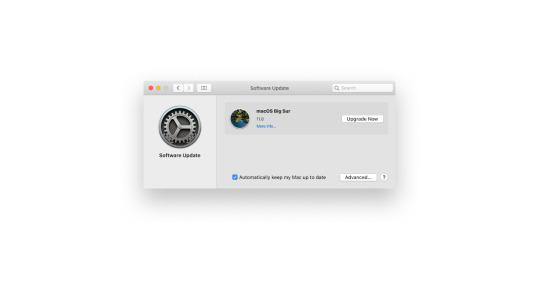
MacBook Air (Retina, 13-inch, 2020)
MacBook Air (Retina, 13-inch, 2019)
MacBook Air (Retina, 13-inch, 2018)
MacBook Air (13-inch, 2017)
MacBook Air (13-inch, Early 2015)
MacBook Air (11-inch, Early 2015)
Imac Late 2015 Os Update Download
MacBook Air (13-inch, Early 2014)
MacBook Air (11-inch, Early 2014)
MacBook Air (13-inch, Mid 2013)
MacBook Air (11-inch, Mid 2013)
MacBook Air (13-inch, Mid 2012)
MacBook Air (11-inch, Mid 2012)
MacBook
MacBook (Retina, 12-inch, 2017)
MacBook (Retina, 12-inch, Early 2016)
iMac Pro
iMac
iMac (Retina 5K, 27-inch, 2020)
iMac (Retina 5K, 27-inch, 2019)
iMac (Retina 4K, 21.5-inch, 2019)
iMac (Retina 5K, 27-inch, 2017)
iMac (Retina 4K, 21.5-inch, 2017)
iMac (21.5-inch, 2017)
iMac (Retina 5K, 27-inch, Late 2015)
iMac (Retina 4K, 21.5-inch, Late 2015)
iMac (21.5-inch, Late 2015)
Is A 2015 Imac Still Good In 2020
iMac (Retina 5K, 27-inch, Mid 2015)
iMac (Retina 5K, 27-inch, Late 2014)
iMac (21.5-inch, Mid 2014)
iMac (27-inch, Late 2013)
iMac (21.5-inch, Late 2013)
iMac (27-inch, Late 2012)
iMac (21.5-inch, Late 2012)
Mac mini
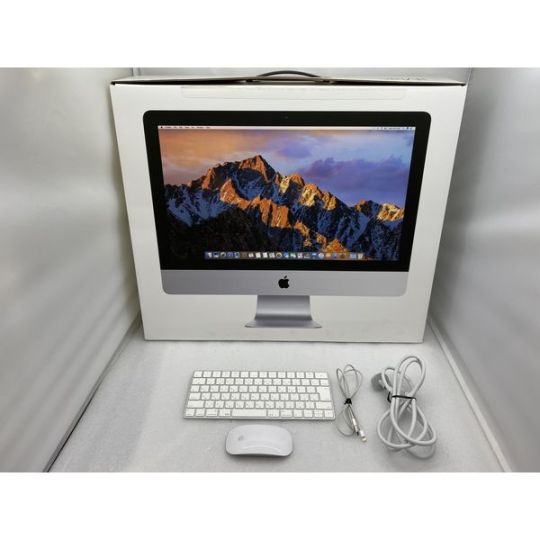
Mac Pro

0 notes
Text
Quercetin could be more effective in inhibiting metastasis compared to resveratrol.
PMID: Nutr Cancer. 2019 Oct 9:1-12. Epub 2019 Oct 9. PMID: 31595775 Abstract Title: The Effect of Resveratrol and Quercetin on Epithelial-Mesenchymal Transition in Pancreatic Cancer Stem Cell. Abstract: Resveratrol and quercetin are phytochemicals that are found in a variety of plants. The aim of this study was to investigate the effect of resveratrol and quercetin on epithelial-mesenchymal transition (EMT) of CD133+ and CD133- pancreatic cancer cells. Cancer stem cells (CD133+ cells) were obtained from the PANC-1 cells by the MiniMACS system. CD133+ and CD133- PANC-1 cells were treated with different concentrations (5, 10, 25, 50, and 100 µM) of resveratrol and quercetin. Cell growth and cytotoxicity were evaluated by MTT assay. Anticancer and anti-metastatic properties of resveratrol and quercetin were determined by immunocytochemistry using antibodies (ACTA-2, IL-1β, N-cadherin, TNF-α, and vimentin). The immunostaining intensity of CD133+ cells was stronger than CD133- cells. ACTA-2, IL-1β, and N-cadherin immunoreactivities were significantly decreased, whereas TNF-α and vimentin immunoreactivities significantly increased in quercetin-treated CD133+ cells. Moreover, N-cadherin and TNF-α immunoreactivities significantly decreased in resveratrol-treated CD133+ cells. The reduction in N-cadherin and ACTA-2 immunoreactivities was higher than the increase in vimentin immunoreactivity, quercetin could prevent EMT to a greater extent than resveratrol in pancreatic cancer stem cells because of the reduced expression ofN-cadherin. Quercetin could be more effective in inhibiting metastasis compared to resveratrol.
read more
0 notes
Text
Новости сайта #ENGINEERING - 工程
New Post has been published on http://engineer.city/using-roller-pinions-in-robots/
Using Roller Pinions In Robots
Engineers mesh Cartesian robot with roller pinion system for superior positional accuracy and repeatability.
Manufacturers in many industries have relied on Mesh Automation’s machine engineering, design and installation services for many years. During that time, the company has completed more than 850 projects of all sizes related to robotic workcells, vision inspection and system integration.
Based in Georgia, USA, Mesh builds custom automation equipment and offers a standard line of pre-engineered modules that make up the backbone of its system. It uses robots and motion-controlled linear systems to move raw materials or finished goods throughout its processes. The equipment is frequently used in many dirty environments typical of fabrication processes such as welding, grinding and finishing.
Using Robots To Weld Studs
One project involved building an automation system for welding studs to a sheet metal door. Design challenges included producing welds strong enough to withstand high pull-out force, preventing backside marking on the door, and maintaining production speed while accurately placing components.
Mesh used six welding guns to ensure strong welds, and non-marking material to eliminate backside marking. For the production speed and placement-accuracy challenges, the engineers decided that a Cartesian robot, rather than a six-axis model, was the best option for this type of system.
Cody Larson, Mesh product manager, says the robot can reach a speed of 1.25 metres per second, while maintaining a position accuracy of ±0,075 mm. It covers a large work area of 1.2 x 2.4m and is rugged enough for 24/7 operation in a welding environment. Other system features include a mounting plate, linear slides, pneumatic actuators, a light ring and a camera for post-assembly inspection.
The Importance Of Robot Movement
A key aspect of system design was finding the best way to move the robot within the work area. Mesh engineers looked at various rack-and-pinion and ballscrew systems before consulting with Mahx F. Linster (MFL), their local motion control expert. MFL recommended that Mesh use the RPS roller pinion system from Nexen, in conjunction with servomotor gearboxes, to optimise robot motion.
“The RPS made the machine design straightforward,” explains Larson. “Also, our expectation concerning performance was exceeded while maintaining our budget.”
Shortly after this project, Mesh developed two modular automation cells. MAC cells are equipped with either a Cartesian robot (servo-powered RPS) or a six-axis robot, as well as manual, semiautomatic or automatic part handling. The skid-mounted design allows for easy installation and repositioning. Other features include built-in LED lights, a process equipment shelf and a pneumatic preparation station.
MiniMAC models feature a small Cartesian robot that operates on a working table and frame of either 0.5m² or 0.7m². These compact semi-automatic machines are ideal for lower-volume applications where quality, consistency and safety are important.
Both series are designed for mission-critical applications involving processes as varied as assembly, welding, dispensing, routing, machining, cutting and inspection. According to Larson, the RPS and other high-quality components contribute to the cells’ robustness.
The Benefit Of Pinions
Unlike the traditional rack and pinion system, the RPS features a pinion consisting of 10 or 12 needle-bearing supported rollers that engage a rack tooth profile. The sealed and lubricated rollers move smoothly along the profile, resulting in zero backlash and 99% efficient conversion of rotary to linear motion. Maximum speed is 11m/s and accuracy is ±0.03mm. The tooth profile is lubricated with a high-performance light grease at installation and then every six months, or two million pinion revolutions.
“Nexen’s application engineering department was very professional, responsive and offered various solutions including custom designs if needed,” says Mesh Automation’s president, Mitch Larson. “Additionally, we required competitive commercial requirements and long-term availability of components. It was a plus that Nexen manufactures in the USA with a convenient location to an international airport. Nexen’s RPS product eventually won the business due to the product being the best fit and quite superior in all technical aspects, ease of maintenance and superior longevity before deterioration of the positional accuracy and repeatability.”
Mesh was able to offer the robot transfer unit for medium payload robots to its customers at an attractive and competitive price. It chose the size 25 RPS roller pinion system for most of its applications but, due to Nexen’s product line and design, it can easily upsize for those very demanding applications requiring the highest torques. The design is easily customisable for length up to 12m, is simple, can accommodate any robot manufacturers’ motor and has a some configurable options such as way covers, auto lubrication, on-board regrip station, weld power supply carriage and a work-in-process tray.
Images:
Categories:
Design
[9] Motors and Drives
Source: engineerlive.com
0 notes
Text
Do you know?
Did you know that how we maintain our machines can be classified in various types and what is interesting to note is each technique has some benefits and some consequences.

In this article, we will understand different types of maintenance techniques their pros and cons along with a brief guideline on how they impact a company’s cost structure with some interesting facts. Contact Minimac to schedule maintenance: +91 7030901266
There are four types of maintenance strategies:
1. Reactive Maintenance: Maintenance is scheduled in response to operational failure.
This type of maintenance is very useful for lowering initial cost, reducing manpower cost as you need fewer staff members and doesn’t require any planning. On the contrary, this strategy compels you to keep more inventory to brace for unexpected failure. This not only leads to a higher cost but also makes the project budgets unpredictable.
2. Preventive Maintenance: Maintenance is scheduled according to historic trends, experience or reliability data considerable guesswork is required.
Preventive maintenance helps plan operations better and provides a better grip on the project budget as you don’t have to keep a lot of inventory on the shelf. However, sometimes we end up sending parts that do not require maintenance which leads to unnecessary expenditure and work.
3. Predictive Maintenance: Progression of failure is monitored. Machine repair is scheduled prior to a catastrophic breakdown.
Reduction in maintenance costs, reduction in repair and Overhaul time and reduction in spare part inventory are some of the advantages of this technique, however high implementation cost, expense on manpower training and increased manpower are some of the downsides.
4. Proactive Maintenance: Ahead of the first initiation of failure, not in response to failure. Focused on the root cause.
This is one of the superior types as the elimination of the cause of failure saves a lot of costs and contributes to the project’s profitability. However, this can be only applied if the manpower has greater diligence and are consistent with observing and recording their feedback. Also, read https://www.linkedin.com/pulse/functions-hydraulic-oil-reasons-its-contamination-anshuman-agrawal/
We at Minimac Systems Pvt Ltd. not only design a maintenance schedule for the lubrication oil but also provide a range of OIL PURIFICATION SYSTEMS & FLUSHING SYSTEMS. Minimac stands for MINImum MAChinery Maintenance.
#oil purification#maintanance#breakdown#oil contamination#machinery#oilflushing#oil cleaning#minimac systems#oil flushing#frf#lvdh#oil purification machine#hydraulic oil#flushing
2 notes
·
View notes
Text
What is varnish and its effects
The condition of the oil in lubrication and hydraulic systems is indicative of the health of the entire system. There are two essentials for ensuring productivity, for avoiding malfunctions and for reducing operating costs:
Monitoring the fluid condition
Continuous maintenance of operating equipment
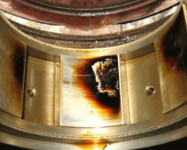
Varnish is a soluble and insoluble contaminant made up of by-products of oil degradation and oxidation. It can appear as a gel-resin like consistency or resemble solid deposits in the oil, or which plates out on the metal surfaces of lube systems. It can be the result of several possible root causes, including high temperatures, electrostatic discharges, lubricant degradation and micro dieseling. Varnish can produce a number of problems related to machine operation, such as valve stiction, lubricant flow restriction, clogged filters, etc.
How is varnish different from sludge?
Varnish is a tough, adherent oxide or carbonaceous material that coats internal machine surfaces. Hot surfaces and/or time will often cure varnish to a hard/brittle consistency.
In contrast, sludge, which is sometimes a precursor to varnish, is soft and sticky and can move about the system until finally coming to rest at sump bottoms, troughs, strainers, filters, and narrow fluid passages.
To know more follow:
https://www.linkedin.com/company/minimacsystemsprivatetlimited
What are the main causes of varnish in your system?
To summarize the prime reasons for varnish generation is following:
Pressure-induced thermal degradation.
Pressure-induced dieseling
Oxidation
Is your system susceptible?
There are a number of reasons why lube oils suffer from high rates of varnish contamination. If your system ticks any of these boxes, then you should test your oil for varnish potential:
for Oil Check call +91 8975150700
Visible deposits or discoloration of lube circuit components
If you switched from group I to group II oil, or if you have blended oils
The high flow rate of lube oil from a small lube oil reservoir
High operating temperature
A gas turbine, gas compressor, or hydraulic system
How to physically identify if there is a change in chemical composition?
The following can be the warning signs that the oil has undergone chemical changes:
Change in oil colour
Strong odour
Change in oil consistency
Sludge and hard deposits on metal surfaces
Visible contaminants in oil samples
If you are facing varnish deposits, two actions are recommended to control it. First, identify the root causes. This will require a systematic study of the possible factors supported by oil analysis. Next, remove the existing varnish in the machine.
At Minimac Systems, we offer flushing services and filter check services which ensure a clean system including oil tanks and lines. Book an appointment with our technical expert by clicking on https://www.linkedin.com/company/minimacsystemsprivatetlimited or call +91 89751 50700
Like, Comment, Share this article to spread awareness and sensitize the reader for Zero Mechanical Breakdown.
#frf#oil flushing#minimac systems#power#oil & gas#hydraulic oil#lube oil filter#minimac#contamination#hydraulic oil filter#coalescer separator#transformer oil#diesel oil purification#lube oil flushing#hydraulic oil filter#hydraulic oil flushing#chemical cleaning#moisture contamination#contamination ocd#contamination control
0 notes
Text
Hydraulic fluid and base stock options
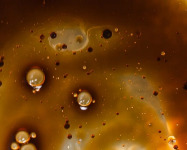
Hydraulic machines produce a lot of excess heat during routine operations, often caused by inefficiencies of the components, like pumps and motors. Without a way to carry heat away from these components, it could result in overheating issues with resulting damage of seals and internal components, especially as a result of low local viscosity. As oil returns to the reservoir, it often passes through a cooler to help maintain optimal temperature range before it is pumped back out to the system. Conversely, hydraulic fluid can carry heat into a system during cold starts, when needed
Hydraulic oil is prepared by the addition of additives in the base stock according to usage, area of usage, ambient condition of usage, the criticality of machines. There can be a variety of base stocks such as mineral oils, synthetic oils, vegetable oils, water-based oils. These base oils can be also further segregated as follows:
Mineral Oils: Group I, Group II, Group III. Mineral oils are used in a variety of industries in various forms such as laxative in biomedicines, veterinary, etc as common ingredients in cosmetics, lubricant, and coolant in mechanical & electrical industries.
Synthetic Oils: Halogenated compounds, Polyglycols (PAG), Polyether, Poly- alpha-olefin(PAO), Polyether, Silicones, Esters, Phosphate Esters, Polyol & Dibasic acid esters. Synthetic oils can be used as a substitute for petroleum refined oils in extreme temperature operations. One of the major advantages of synthetic oil is its ability to resist chemical decomposition in the presence of water, it also separates from water easily and can operate at higher pressures.
Vegetable Oils: Natural vegetable oils such as Canola Oil, Soyabean Oil, Sunflower Oil, Cornflower Oil. Vegetable oils are mainly used in the food industry, they are also used in personal care and cosmetic industries, paint industries. They are also used in electrical industries as insulators due to their non-toxic nature.
Water-Based Oils: Water Glycols, Emulsions, Synthetic Solutions. Water-based oils such as water glycols, emulsions have excellent fire-resistant properties. Excellent fire-resistant properties along with good cost and performance make it the right choice for many industrial applications. They also have good operating pressure and temperature ranges.
Thus from the above illustrations, we can identify different types of base stocks and their segregations, and use of these segregations according to the customized needs.
Also read: https://www.linkedin.com/pulse/functions-hydraulic-oil-reasons-its-contamination-anshuman-agrawal/
Minimac focuses on lubrication reliability and contamination control - Clean Oil, Healthy Machine! Call +91 7030901266 for Condition Monitoring.
#frf#oil flushing#minimac systems#power#minimac#oil & gas#hydraulic oil#lube oil filter#contamination#hydraulic oil filter#oil condition monitoring#frf condition systems#coalescer separator#oil dehyration#electrostatics lube cleaner#transformation oil purification#diesel oil purification#oil filtration system#oil purification system#lube oil flushing#chemical cleaning#oil filteration#oil filtration#filtration skid
1 note
·
View note
Text
Functions of hydraulic oil and the reasons of its contamination
There are four basic functions of hydraulic oil:
To act as an energy transmission medium
To Lubricate internal moving parts of components
To act as a heat transfer medium
To seal clearances between moving parts

Proper hydraulic fluid maintenance helps to prevent or reduce breakdown maintenance. This is accomplished through continuous improvement program that minimizes and removes contaminants. Hydraulic fluid is expected to create a lubricating film to keep precision parts separated. Ideally, the film is thick enough to completely fill the clearance between moving parts. This condition results in low wear rates. When the wear rate is kept low enough, a component is likely to reach its intended life expectancy.
The actual thickness of a lubricating film depends on:
fluid viscosity
applied load
relative speed of the two surfaces
So, if after multiple cycles the oil loses its viscosity or is contaminated. It will lead to addition friction and wear and tear.
What harm will the contaminants make?
If not properly flushed, contaminants from manufacturing and assembly will be left in the system. These contaminants include dust, welding slag, rubber particles from hoses and seals, sand from castings, and metal debris from machined components. Also, when fluid is initially added to the system, contamination is introduced. During system operation, contamination enters through breather caps, worn seals, and other system openings. System operation also generates internal contamination. This occurs as component wear debris and chemical by-products react with component surfaces to generate more contamination.
What are the types & sources of Contamination?
There are basically 4 sources of contamination:
Built-in Contamination
Natural Contamination
Ingressed Contamination
Generated Contamination
While the first three types of contamination is self-explanatory, there is the further classification of generation contamination on the basis of how it is generated:
Abrasive Wear: Hard particles bridging two moving surfaces, scraping one or both.
Cavitation Wear: Restricted inlet flow to pump causes fluid voids that implode causing shocks that break away critical surface material.
Fatigue Wear: Particles bridging a clearance cause a surface stress riser that expands into a spall due to repeated stressing of the damaged area.
Erosive Wear: Fine particles in a high-speed stream of fluid eat away a metering edge or surface.
Adhesive Wear: Loss of oil film allows metal to metal contact between moving surfaces.
Corrosive Wear: Water or chemical contamination in the fluid causes rust or a chemical reaction that degrades a surface.
Are contaminants visible with naked eye?
Particle sizes are generally measured on the micrometer scale. One micrometer (or micron) is one-millionth of one meter, or 39 millionths of an inch. The limit of human visibility is approx.. 32μm micrometers. Keep in mind that most damage-causing particles in hydraulic or lubrication systems are smaller than 14μm micrometers. Therefore, they are microscopic and cannot be seen by the unaided eye. To put the sizes in perspective, below are the sizes of some known objects.
Hence filtration of hydraulic oil is of prime importance. Minimac System provides an array of the solution in this regard. What we also do is filter check via our experts for any of your rig/equipment.
At Minimac Systems we offer Flushing Services and Filter Check Services which ensure a clean system including oil tanks and lines. Book an appointment with our technical expert by clicking on https://www.linkedin.com/company/minimacsystemsprivatetlimited or call +91 8975150700
Like, Comment, Share this article to spread awareness and sensitize the reader for Zero Mechanical Breakdown.
#frf#oil flushing#minimac systems#power#minimac#oil & gas#hydraulic oil#lube oil filter#contamination#hydraulic oil filter#lube oil flushing#electrostatics lube cleaner#oil dehydration systems#frf condition systems#transformer oil#diesel oil purification#coalser separator#oil analysis#oil filter systems
0 notes
Text
Standards of turbine oil
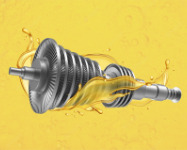
A) BSI (British Standards) – BSI BS 489:1999: Specification For Turbine Lubricants.
B) DIN (German Institute for Standardization DIN 51515-1, 51515-2: This document specifies minimum requirements for oils for high thermal stress (high-temperature service) in turbines.
C) ABB (ABB Group) ABB G12106: Ultra-clean turbine oil, Long-life, Rust & Oxidation-inhibited circulating oil.
D) ASTM International – ASTM D4304: Define the properties of the mineral and synthetic oil-based turbine lubricating oils that are functionally interchangeable with existing oils of this type, are compatible with most existing machinery components, and with appropriate field maintenance, will maintain their functionality.
E) GE (General Electric) GE: GEK-32568: Lubricating Oil Recommendations for Gas Turbines With Bearing Ambients above 500°F (260°C)
Also Read: https://www.linkedin.com/pulse/mandatory-properties-steam-gas-turbine-oil-anshuman-agrawal-mlt-1-/
We at Minimac study your maintenance needs and provide the best solution. We believe in Discern, Design & Deliver.
Call +91 7030901266 for Mechanical Maintenance & Oil Check.
#frf#oil flushing#minimac systems#power#minimac#oil & gas#hydraulic oil#lube oil filter#contamination#hydraulic oil filter#oil analysis#oil filters#oil industry#oil and gas#oil#oil purification system#oil purification system#oil purification#oil contamination#mlc lvdh#lvdh full form#lvdh#mlc#transformer oil filtration#oil filtration machine#oil filtration systems#oil dehyration#electrostatics lube cleaner#transformer oil#transformers
0 notes
Text
Can all contaminants be seen with naked eyes?
As a part 2 of #knowyouroil series, we will discuss about Particle Contamination. Whenever we talk about contamination the first thing that comes to our mind is solid particles that we can see or feel. But what we do not understand is how big a particle can really cause wear and tear to your machines, can all contaminants be seen with naked eyes? Is it too late to wait until then?
To answer the above questions we must first understand the actual clearance size of the different types of lubrication film formed between rolling> and rotating components which is essential for providing proper lubrication. Oil film thickness in machinery is measured in microns (µm), or one-millionth of a meter.

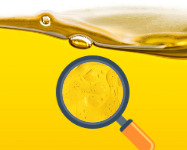
The contaminants that are considered to be most damaged are from size 2 to 20 µm and avoiding these are key to keeping your machinery breakdown free.>


Get your machine's oil check today with our technical expert call +91 7030901266. Ask for a brochure today.
We at Minimac System Pvt. Ltd. not only design a maintenance schedule for your lubrication oil but also provide OIL TESTING and FILTRATION services and the filtered oil complies to the ISO standard of Super Clean oil as we stand for MINImum MAChinery Maintenance.
#frf#oil flushing#minimac systems#power#minimac#oil & gas#hydraulic oil#lube oil filter#contamination#hydraulic oil filter#oil filters#filters#lube oil flushing#chemical cleaning#electrostatics lube cleaner#oil dehyration#oil dehydration systems#transformation oil purification#coalser separator#metal#mining#steel#oil and gas#oil lubrication#oil contamination#water contamination#contamination control#transformer oil#transformer oil cleaning#transformer oil filtration
0 notes
Text
Common properties that are must haves in the turbine oil

Oxidation Stability: Oxidation stability is a chemical reaction that occurs with a combination of the lubricant and oxygen. The rate of oxidation is accelerated by high temperatures, water, acids, and catalysts such as copper. The service life of a lubricant reduces with an increase in temperature.
Viscosity Index: The viscosity index (VI) is an arbitrary, unit-less measure of a fluids change in viscosity relative to temperature change. It is mostly used to characterise the viscosity-temperature behaviour of lubricating oils. The higher the VI, the more stable the viscosity remains over temperature fluctuations.
Filterability: Capable of being filtered or separated by filtering.
Low Sludging Formation Tendency: Having low sludge formation tendency.
To know more about sludging, read: https://www.linkedin.com/pulse/what-varnish-its-effects-anshuman-agrawal
We at Minimac study your maintenance needs and provide the best solution. We believe in Discern, Design & Deliver.
Call +91 7030901266 for Mechanical Maintenance & Oil Check.
#frf#oil flushing#minimac systems#power#minimac#oil & gas#hydraulic oil#lube oil filter#contamination#hydraulic oil filter#chemical cleaning#frf condition systems#oil condition monitoring#electrostatics lube cleaner#oil dehyration#coalescer separator#transformation oil purification#diesel oil purification#oil analysis#oil filters#oil and gas#oil industry#oil#turbine oilanalysis maintenance lubrication reliability contaminationcontrol oil powerplants oilfiltration rotatingequipment mechanical bre#power generation#metal#heavy metal#black metal#mining
0 notes
Text
Steps to achieve perfect oil lubrication
It is a well-known fact that lubricant’s key responsibility is surface separation and protection. It reduces friction and saves a lot of costs that a company incurs in events of premature failure. One of the things that people talk about very seldom is when to lubricate and how much to lubricate. Does over lubrication saves or increases the maintenance expense? Is there a sweet spot or optimum point for lubrication?
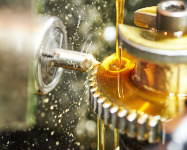
As presented in a report by Dr. H. Peter Jost’s Projected Economic Benefits Associated With Improved Lubrication Design and Practice, “A large percentage of lubrication programs operate inefficiently and on auto-pilot”.
Some of the properties where too little or excess consumes too much energy:
Viscosity
Grease Consistency
Grease Load
Oil Volume
Filtration
Grease Bleed
Summability: grease’s ability to relax in its reservoir under gravity and be fed into the pump
4 steps of the Oil Lubrication to save costs and conserve energy are:
1. Calculate the machine lubrication schedule on the basis of the machine’s operating environment and characteristics. It is often observed that the lubrication schedule of the slow-moving machines is scheduled very frequently and that of fast-moving machines very seldom. This irregularity in relubrication leads to either excess lubrication and thus wasting the product or insufficient lubrication leading to friction between surfaces, higher wear, and tear and premature failure. Contact Minimac, to schedule maintenance and for filter audit drive, follow: https://www.linkedin.com/company/minimacsystemsprivatetlimited
2. Machinery Operators should conduct a basis pre-trip each day to check for the physical properties of the lubrication of oil. In this way, early contamination conditions could be detected.
3. Cleaning of lubricant sump should become a schedule to extend on the intervals to change sump oil to save new lubricant cost. This activity also saves varnish and sludge appearance in tanks.
4. Skip all 3 steps and call Minimac +91 7030901266
We at Minimac Systems Pvt Ltd. not only design a maintenance schedule for the lubrication oil but also provide a range of OIL PURIFICATION SYSTEMS & OIL TESTING KITS. Minimac stands for MINImum MAChinery Maintenance.
#frf#oil flushing#minimac systems#power#minimac#oil & gas#hydraulic oil#lube oil filter#contamination#hydraulic oil filter#transformation oil purification#electrostatics lube cleaner#coalescer separator#oil dehydration systems#diesel oil purification#chemical cleaning#filter replacements#filter#oil filter machine#oil filters
0 notes
Text
How to manage the cost of Lubricant Filtration
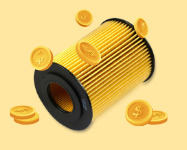
The cost of removing dirt from oil is substantial, mainly when plants and fleets operate in dusty environments. We are aware of the fact that contamination control is optional but an important maintenance strategy. You may find it surprising, but most oils purchased these days are not filtered before being sold. It may look transparent, but it has particles that are not expected to be in new oil. The existing contaminants of lubricants must be addressed first before putting into service. Achieving cleanliness of oil at economical rates should be taken care of by smart maintenance professionals.
As already mentioned, many new lubricants may have impurities that contribute to premature filter plugging. An oil change can be more economical than filtration (in some cases). In simple words, filters last if they don’t plug in particles/impurities. A careful inspection must be done in this case. If you change filters very often, it will be a waste of resources. The additional cost includes inventory, labour cost, disposal of used filter and waste oil, scheduling cost, etc. If you change a filter too late, then it can be a danger for the oil and machine. Many technologies like bypass indicators, delta-P indicators, online particle counting, and alerts are available to improve the filter change intervals. It’s very important to remove the particles at the same rate they enter into the oil.
To learn about the latest technologies, Join our Community
Following are the factors which improve filters and their economy:
Filter with the right micron – Filters must have the right micron size to ensure the proper flow of lubricant. The appropriate micron should be checked before selecting a filter.
Temperature – A lubricant may have difficulty passing through a filter in cold temperatures compared to warm temperatures.
Viscosity – Lubricant viscosity is an important aspect too. For Low viscosity lubricant, a low micron rating filter should be considered and vice versa. This is due to the machine tolerance.
Moisture – If there is less moisture, then a spin-on or drop-in filter can be used to remove water from a machine. If the water is in a large amount, then a vacuum dehydrator can be the best option to remove water from a lubricant, as in this case, heat and suction are used to remove moisture.
Thus, it is important to select filters considering size, media type, capacity, filter design, dirt-holding, location of usage, pressure, flow, etc.
Connect with Minimac Experts: Click here
#frf#oil flushing#minimac systems#power#minimac#oil & gas#hydraulic oil#lube oil filter#contamination#hydraulic oil filter#lube oil flushing#lube oil#oil contamination#filtration skid#oil filter machine#oil filter systems#coalescer separator#oil dehydration systems#electrostatics lube cleaner#transformation oil purification#coalser separator#disel oil#diesel oil purification
0 notes